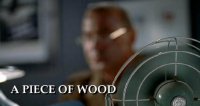
 |
|||||||||||||||
 |
A Piece of Wood (2006) |
|||||||||||||||||||||||||||||||||
|
"A Piece of Wood" first appeared in Esquire, June 1952.
Its first book appearance was in Long After Midnight (1976). |
Screenplay: Tony Baez Milan, from Bradbury short story Directed by Tony Baez Milan Cast: Larry Dirk, Glen Anthony Vaughan |
|
||||||||||||||||||||||||||||||||
|
Sergeant Hollis, a troubled young man inside a world that has been at war for sixteen years, reveals to General Cross - his commanding officer - that he has invented a device to do away with the weapons of the world by turning them to rust. Cross believes Hollis to be delusional. However, shortly after Hollis leaves the General's office, the General finds his pen has turned to rust. And so has his service revolver. Cross orders his guards not to let Hollis leave the base, but is told that his men are powerless to stop him. Going to the window, he sees and hears mayhem and violent panic as the ordered world built around warfare descends into chaos. In a furious rage, the General reaches for a wooden chair and smashes it to pieces. He picks up one of the pieces and hefts it like a club. He opens the door to the outside world and roars with rage... [Source: http://www.urbanarchipelagofilms.com] |
||||||||||||||||||||||||||||||||||
|
||||||||||||||||||||||||||||||||||
|
This short film is an elegant demonstration of what can be achieved on a small budget and with a tight production schedule. Using just two characters, one set, and some creative visual and audio effects, the film gives a faithful, thoughtful and appealing presentation of Bradbury's story. Kambiz Hemati's set effectively conveys a blend of temporariness and permanence: a temporary war-time building - a tin hut - yet elevated to a state of permanence. This reflects the state of mind of Cross, the career army General, for whom warfare is central to existence. By confining us to this set, Hemati and director Milan have anchored us to the mindset of Cross. This basic strategy is already there in the Bradbury story, but is only implied. Since a film-maker must concretise, make real what a short story writer can leave floating in the background, whole new choices can arise in adaptation. The director and designer here have made the right choice. Bradbury's story is essentially an allegory, a form which is rare in his body of work overall. It is also told almost entirely in dialogue, and so is arguably one of the most straightforward stories to dramatise. Of course, to make it work a strong pair of actors is required, and that is precisely what we have here. Vaughan brings a combination of youth and ingenuity: his Hollis is not naive, and projects the right combination of youth and experience (he is a Sergeant after all). Dirk brings authority and control: to the extent that when he loses control we see an incredible primitive, primal set of responses. This is a story of a clash of ideologies, pacifism versus warmongery. But it is also beautifully illustrates the smugness of anyone who achieves a state of permanent comfort, and the panic that subversion can bring. Milan's screenplay has captured all of this, both in the elements lifted straight from the short story, and in the inventions new to this adaptation. I have one or two small reservations about the production. There is something not quite right with the editing; a few cuts fail to flow, and some of them show awkward continuity errors. The script relies too much on dialogue, whereas it could make more of silences and the space between the characters. The line "My service revolver!" is unnecessary, as the production team have produced a perfectly beautiful rust-pile in the shape of a service revolver. Taken together, these small flaws suggest a director more at home with stage than screen, or more comfortable with words than images. However, none of these is serious enough to undermine the film's strengths and achievements. |
||||||||||||||||||||||||||||||||||